Gas chamber at Station Z execution site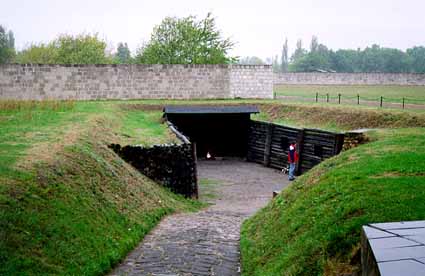 Station Z was the nickname that the SS gave to the execution site at Sachsenhausen. Beginning in the fall of 1939, Station Z was the site where prisoners who had been condemned to death in a Nazi court were executed by a firing squad. The photograph above shows the "partially reconstructed execution trenches with bullet catch and automatic gallows." According to the memoirs of Rudolf Höss, who was on the staff at Sachsenhausen for a time, anyone who was convicted of war-time sabotage or enemy activity against the state was sent to the nearest concentration camp for execution, and the first such execution after the war started in 1939 was carried out at Sachsenhausen when a Communist, who had refused to perform his assigned air raid duties in an aircraft factory, was shot. Staton Z is also the locaton of a gas chamber that was first put into operation in 1943, presumably to gas Russian POWs since there were no Jews in the camp at that time. At a Military Tribunal conducted by the Soviet Union in October 1947, Camp Commandant Anton Kaindl confessed to the gassing of prisoners, on his own authority, at Sachsenhausen. The gas chamber and the execution site were both inside the Industrial Yard, where the factories were located; they were separated from the prison enclosure by a brick wall. The name Station Z was intended to be a joke, according to the Memorial Site, because the entrance to the camp was through Building A, which was the gate house, and Station Z was the exit from the camp for those who were executed. After the invasion of the Soviet Union in June 1941, the Russian Prisoners of War, who were Communist Commissars, were brought to Sachsenhausen to be executed, on the orders of Adolf Hitler. According to a pamphlet distributed at the Memorial Site, at least 12,000 Soviet Commissars were executed at Station Z in the fall of 1941. Rudolf Höss wrote the following in his autobiography: The reason for this action was given as follows: the Russians were murdering any German soldier who was a member of the Nazi party, especially SS members. Also, the political section of the Red Army had a standing order to cause unrest in every way in any POW camp or places where the POWs worked. If they were caught or imprisoned, they were instructed to perform acts of sabotage. There were no American Prisoners of War who were brought to the concentration camps and executed by the Germans; both Germany and America followed the Geneva convention regarding POWs during the war, but the Russians had not signed the most recent version of the Geneva convention and were not following it, so the Germans believed that they were not bound to the convention with regard to the Russians. The photo below shows the floor of the gas chamber, which was disguised as a shower room. In the background is the execution trench where condemned prisoners were shot.  The photograph below shows the location of the entrance into the gas chamber which was from the undressing room, shown in the background. Notice the drain hole in the floor of the gas chamber, which was to fool the prisoners into thinking that this was a real shower room. This must have been a fake drain because Zyklon B was used to gas the prisoners, and according to the directions from the manufacturer, the gas pellets were not to be swept down a drain for fear of poisoning the whole camp. The gas chamber was very small, no more than 7 feet wide by 9 feet long.  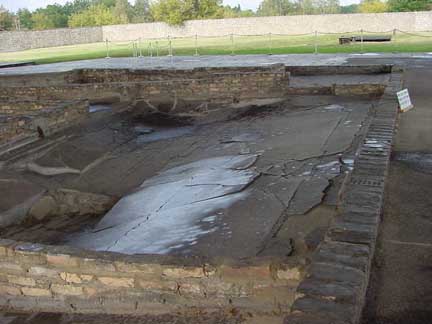 The floor of the undressing room is shown in the photograph above. It is about 4 times the size of the gas chamber, or about 14 feet wide by 18 feet long. The gas chamber, which was added in March 1943, was constructed in part of the space that was being used as a garage. In the photograph below, one can see the driveway, going into what was formerly the garage. The three steps lead up to the exit from the gas chamber. 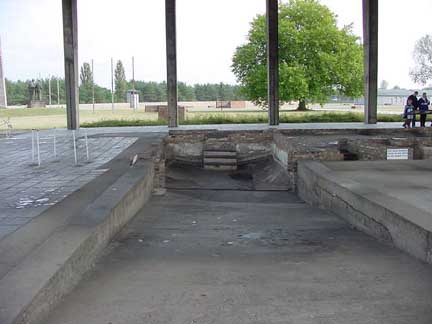 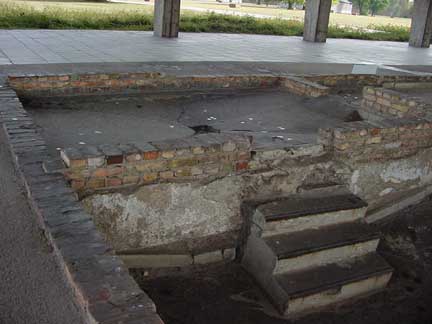  The photograph above show a map which has been placed at the site of the ruins of the crematorium and gas chamber. The red line shows the route that the victims took as they entered the building through a door near the ramp that led into the garage. The route led through a room that was connected to the undressing room, then through the undressing room into the gas chamber. The bodies were taken out of the gas chamber through a door into the garage, going down three steps, then through the garage and up the driveway to the outside. From there, the bodies were carried through a door into the oven room where there were 4 incinerators used for cremation. According to a Museum pamphlet: After the Soviets departed, the GDR paramilitary police blew up the building in order to clear space for a firing range. In 1961, at the insistence of former prisoners, the building foundations were secured and integrated into the Sachsenhausen memorial. The ruins of the crematorium and gas chamber are covered by a massive structure, which looks like a gas station without the pumps. Visitors are not allowed to walk onto the floor of the ruined building because the sign says that there is a danger from the shifting ground beneath the former foundations of the building. The Museum pamphlet says that the Jews were evacuated from Sachsenhausen and sent to Auschwitz in October 1942 before the gas chamber was ready for operation in 1943. When the Auschwitz death camp closed in January 1945, some of the survivors were brought back to Sachsenhausen where it is possible that they were gassed. According to information presented at the Jewish Museum at Sachsenhausen: ... during the very last weeks, thousands of people were still being killed in satellite camps and on the death marches, or in Iindustriehof," the industrial yard of Sachsenhausen. On the same day that I first visited Sachsenhausen in the fall of 1999, I took the train to the suburb of Wannsee near Berlin and toured a Jewish Museum there which presented information that all of the Nazi gas chambers were in what is now Poland and none were located in present-day Germany. However, the Memorial Site at Sachsenhausen maintains that the gas chamber, disguised as a shower room, at Sachsenhausen was used to kill prisoners. In the Museum at Sachsenhausen, the camp is called a "Death Camp." 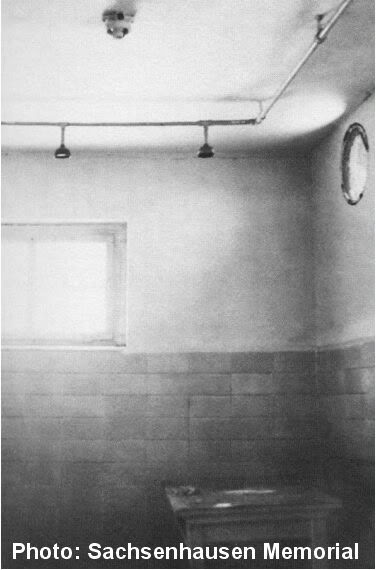 Ruins of Cremation OvensTable of ContentsHome |